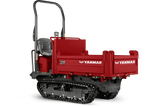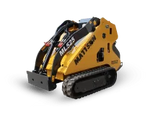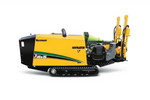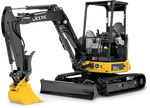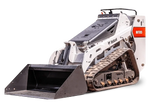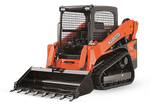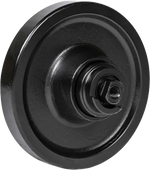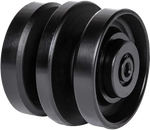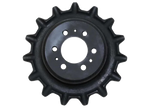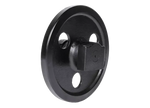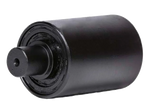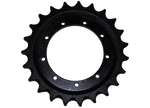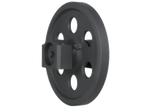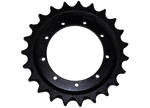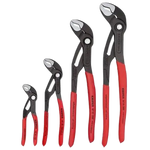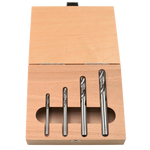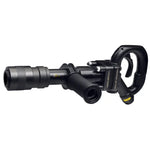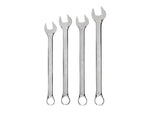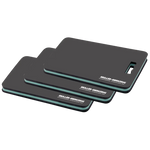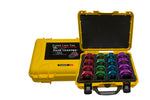Kubota SVL97-2 Review
Written by Luis Montes Updated On June 3, 2024

To the present year, 2024, the Kubota SVL97-2 is the company’s biggest and strongest compact track loader. It’s so powerful, some people call it a mini dozer.
The machine is the result of an improvement process starting with the SVL90. Yet, some drawbacks have been carried out over the years, making the machine seem somewhat outdated, especially regarding the cab. Nevertheless, the SVL97-2 has been among the most popular CTLs in several US states.
In this post, we want to show you an unbiased review of the Kubota SVL97-2, covering the significant changes between the previous versions, comparing their specs, overviewing pros and cons, and sharing opinions and testimonials.
The Evolution of the SVL90 Series

The main reason for upgrading the SVL90 was the Environmental Protection Agency’s (EPA) Tier 4 engine emissions standards. Tier 4 aims to significantly reduce nitrogen oxide (NOx) and particulate matter (PM) emissions.
The Last Step to Comply with the EPA Tier 4 Final Standards

The common rail system (CRS) and diesel particulate filter (DPF) on the SVL90 make it an Interim Tier 4 complaint. However, the Tier 4 Interim was a transition step to the Tier 4 Final regulations, which require additional reductions in NOx and hydrocarbon emissions.
Most of the big changes in diesel engines have been on those above 75 HP—which was the case for the SVL90. They required new emission reduction systems using selective catalytic reduction (SCR) and diesel exhaust fluid (DEF)—a mixture of water and a little bit of urea that helps turn NOx into harmless nitrogen and water vapor.
The CRS system, DPF, and DEF fluid finished the emissions updating process, making the SVL95-2 a Tier 4 Final complaint.
Let’s briefly break down the mentioned technologies’ role in reducing emissions.
The common rail system controls the fuel injection timing and quantity to enhance combustion efficiency and minimize the formation of NOx and particulate matter.
The DPF traps and stores exhaust soot and NOx. Because DPFs have a finite capacity, the buildup soot must be periodically emptied or “burned off” to regenerate the DPF. Kubota’s original regeneration system automatically burns accumulated soot in the DPF to keep the muffler clean for longer operations.

Once the DPF removes the particulate matter, the exhaust gases flow through the Selective Catalytic Reduction (SCR) system, where a nozzle sprays Diesel Exhaust Fluid (DEF) into the exhaust stream.
If the SVL95-2 complied with the emission regulations, why did we need the SVL97-2? Because Kubota—and most of the industry—struggled with a bosch sensor that sits on top of the tank to measure the quality of the DEF fluid. The source of the problem was the ammonium that the DEF fluid produced, which crowded and damaged the inside of those sensors.
The major pain wasn’t the annoying screen warning but the machine going into “limp mode,” as you can read from several unhappy customer testimonials on websites such as Heavy Equipment and Tractor By Net forums. The limp mode restricts the engine’s power output and limits the speed at which the CTL can operate.
Kubota first integrated DEF around 2012 and has refined it over the last 10+ years. After several iterations, the SVL97-2 fixed the sensor issue, allowing it to last for a long time.
Due to the need to accommodate the DEF tank in the rear end, the SVL95 and 97 are 6.5” longer than the 90 version, which increased their ROC (at a 35% tipping load) by 6.4%.
An Advanced Hydraulic System
Besides the DEF fluid, another upgrade from the SVL90 to the SVL95-2 and the 97-2 was transitioning from an open center type hydraulic system to an advanced hydraulic system: the CCLS (closed center loop system).

In an open center system, the pump—usually a gear type—continuously pumps oil through a series of valves. There are some issues with that design.
First, the pump output is linked to the engine’s RPM, so at low engine speeds, the pump output drops. Therefore, hydraulic circuits respond slowly.
Because oil must flow continuously and through all control valves—in series—when you activate one valve, you cut off the oil flow to the others in the system, so the second circuit in operation will function slowly.

A closed center loop system has parallel valves and a variable piston pump that sends oil “on demand.” Since oil doesn’t have to pass through all the valve blocks, the system can divide the flow into multiple circuits at the same time for optimal operating efficiency.
SVL90 Series Specs Comparison
The SVL90, 95, and 97 specs are pretty much alike. Let’s focus on the most significant values and compare what has changed.
Dimensions
The need for a DEF tank in the SVL95-2’s rear end increased the compact track loader’s length and turning radius.

Photo source: www.kubota.com.
| Model in (mm) | SVL75-2 | SVL75-3 | |
|---|---|---|---|
| A | Length of track on ground | 65.6 (1,667) | 65.6 (1,667) |
| B | Track gauge | 59.5 (1,512) | 59.5 (1,512) |
| C | Length w/o bucket | 117 (2,972) | 123.5 (3,137) |
| D | Length w/bucket on ground | 148.2 (3,764) | 154.6 (3,929) |
| E | Height to top of cab | 83.4 (2,118) | 83.3 (2,116) |
| F | Bucket hinge pin height at max. lift | 128.6 (3,266) | 128.5 (3,264) |
| G | Rollback angle at carry position (degree) | 27 | 27 |
| H | Reach at max. lift and dump | 40.7 (1,035) | 40.7 (1,035) |
| I | Ground clearance | 11.8 (299) | 11.5 (293) |
| J | Departure angle (degree) | 31 | 31 |
| K | Max. dump angle (degree) | 43 | 43 |
| L | Vehicle width | 77.2 (1,962) | 77.2 (1,962) |
| M | Width with bucket | 80 (2,032) | 80 (2,032) |
| N | Turning radius from center-machine rear | 113.5 (2,882) | 127 (3,220) |
Mechanical and Hydraulic Specifications
The SVL97-2 complies with the Tier 4 Final standards with its V3800-TIEF4 engine and DEF fluid. The DEF tank in the machine’s rear end added counterweight, increasing the tipping load and rated operating capacity (ROC) at 35%—a safety measure indicating 35% of the tipping load.
| Model | SVL90 | SVL95-2 / SVL97-2 | ||
|---|---|---|---|---|
| Engine | Model | V3800-CR-TE4 | V3800-TIEF4 | |
| Gross output - HP (kW)/rpm | 92.0 (68.6)/ 2,400 | 96.4 (71.9) / 2,400 | ||
| Net output - HP (kW)/rpm | 68.8 (51.3)/2,400 | 73.2 (54.6) / 2,400 | ||
| Loader Performance | ROC (-35% tipping load) - lbs (kg) | 3,010 (1,365) | 3,200 (1,451) | |
| Tipping load - lbs (kg) | 8,600 (3,900) | 9,143 (4,147) | ||
| Breakout force | Bucket - lbf (kg) | 7,961 (3,611) | 7,961 (3,611) | |
| Lift arm - lbf (kg) | 6,742 (3,058) | 6,742 (3,058) | ||
| Lift arm path | Vertical | |||
| Undercarriage | Track width | Standard in (mm) | 17.7 (450) | 17.7 (450) |
| Track rollers (per side) | 5 | |||
| Travel speed | Low - mph (km/h) | 5.0 (8.0) | 5.0 (8.0) | |
| High - mph (km/h) | 7.3 (11.7) | 7.3 (11.7) | ||
| Min. ground clearance - in (mm) | 11.7 (296) | 11.5 (293) | ||
| Hydraulic System | Aux. hydraulic flow | Std. - gpm ( l/min) | 25.1 (94.9) | 23.1 (87.6) |
| High - gpm ( l/min) | 36.5 (138.3) | 40.0 (152) | ||
| Aux. hydraulic pressure | psi (kgf/cm2) | 3,555 (250) | 3,553 (249.8) | |
| Operating weight (Includes operator weight 165 lbs.) - lbs (kg) |
11,023 (5,000) / 11,188 (5,075) | 11,299 (5,125) / 11,464 (5,200) | ||
Functions and Features
In addition to what we mentioned throughout the article, the SVL97-2 has telematics, a standard self-leveling function, a load-sensing system, and a roll-up door.
If you haven’t heard of telematics, it lets you upload your engine diagnostic information—hour meters, fuel levels, hydraulic temperatures—to the cloud and watch for potential problems before they happen.
You can also use a Kubota app to locate your compact track loader with GPS location or set a geofencing.
Geofence lets you create a virtual boundary around a real-world geographic area. When the equipment crosses the boundary, the system automatically triggers alerts or actions, like turning off the equipment or sending a command to guide it back to the allowed area.
The self-leveling function helps keep the bucket or fork horizontal without manually adjusting the angle during lifting.
The load sensing system is part of the closed center loop system. It adjusts the pump’s output pressure and flow based on the demand of the hydraulic load. Here’s the working principle:
The load sensing feature adjusts the pump’s output to match the actual demand of the hydraulic load. It uses a pressure signal from the load (the actuator or most demanding function) to communicate with the pump, which then varies the flow and pressure. The system only delivers the power needed for the operation, reducing energy consumption and heat generation.

The SVL97-2 roll-up door lets you quickly get in and out of the cab or work with the door open, even if the bucket is up, something most CTLs can’t do.
Some optional features we recommend getting are the high-flow auxiliary hydraulics and the hydraulic quick coupler.
The first one increases the hydraulic flow from 23.1 gpm to 40 gpm to operate hydraulic attachments that require more power and fluid flow to function effectively. There are five presets for hydraulic settings to dial down the hydraulic flow so as not to blow up the seals on your attachments—oil flow control is available only for high flow.
With the optional hydraulic quick coupler, you can easily change between attachments from your cab using a button instead of doing it manually.
The SVL97-2 Stronger Features
The Kubota SVL97-2 is a fast and powerful compact track loader thanks to its 96.4 HP engine.
Its hydraulic pilot controls make the machine react quickly to your commands. Pilot controls utilize small pilot lines (hydraulic hoses) that carry fluid to control valves, which manage the main hydraulic flow based on the pilot signal.

Photo source: www.ritchielist.com.
The SVL97-2 combines a dozer’s strength and a skid steer’s versatility due to its size, maneuverability, and varied attachments:
- Auger: For drilling holes in the ground.
- Grapple Bucket: To handle awkward materials such as logs, rocks, and scrap.
- Pallet Fork: To load, unload, and move palletized loads.
- Hopper Broom: For cleaning and sweeping surfaces like construction sites, roads, and parking lots.
- Breaker: It’s a hydraulic hammer for demolishing concrete structures or rocks.
- Rotary Cutter: For clearing vegetation, cutting brush, and mowing overgrown fields.
- Heavy Duty Bucket: For intense digging, loading, and material handling.
- Cold Planer: To cut and mill concrete and asphalt.
- 4-in-1 Bucket: A 4-in-1 bucket, grapple, bulldozer, and scraper blade.
- Rotary Tiller: It breaks up hard soil into loose dirt for planting.
- 3-pt Hitch Adapter: It allows you to use agricultural implements requiring a three-point connection for versatile tasks typically reserved for tractors.
- Tree Puller: To remove trees and other vegetation from the ground.
- Snow Blade: Pushes snow aside to clear roads, driveways, and parking lots.
- Snow Blower: Removes snow by blowing it to the side.

Photo source: www.kubota.com.
The SVL97-2 isn’t a machine for landscaping. Its weight will tear up lawns, ruin asphalt, or damage a nice finished property. It’s a compact track loader for large construction jobs, like grading an entire property or building a foundation.
Five triple flange rollers safely support and spread the SVL97-2’s 11,574 lbs of weight—plus the 9,143 lbs it can lift. The undercarriage is welded into the mainframe for maximum durability, and its 11.5” of ground clearance lets you travel over rugged terrain efficiently.

The undercarriage’s components have a wide open arrangement for easy cleaning, and the beveled roller guard helps dirt fall off instead of building up inside it.
If you buy the SVL97-2 brand new, it comes with standard rubber tracks 17.7 inches wide and 4.4 psi of ground pressure, lower than smaller models like the SVL65 and SVL75. But don’t be fooled by the numbers. The SVL97-2 is extremely heavy and will rip lawns and damage delicate terrain and nice finished surfaces.

Flaws of the SVL97-2
Most SVL97-2 owners complain about the cab. Although comfortable and simple, the design already feels old. It hasn’t changed since the SVL90—10 or 12 years ago. The SVL75 also struggled with this until the release of the SVL75-3 model. We cover the SVL75-3 cab improvements over the previous version in our SVL75-2 review.
There’s been enough time to change the following things:
- The awkward radio position—is on the left of the seat backrest.
- There are no HVAC vents on the right side.
- The design and location of the washer bottle. It’s inside the cab over the operator’s right shoulder, and if you fill the bottle all the way up, it’ll spill all over the cup holder and your shoulder while the machine moves.
- When working with the door open, the safety pins rattle too much.
- Halogen lights instead of LEDs.
The roll-up door is one of the cab’s best features, but its rail system can get clogged with dirt and debris, making it difficult to slide the door. Lubricate the rails frequently.

Photo source: www.ritchielist.com.
The SVL97-2 is an overall accessible machine. However, the hydraulic and fuel inlets are a bit hard to reach because the arms get in the way. Also, the screen of the fuel inlet (to keep out dirt debris) and the shallow angle of the fill tube make diesel splash back when filling the tank.
Similar Machines to the Kubota SVL97-2

The SVL97-2 is similar to these compact track loaders:
- Takeuchi TL12V2.
- John Deere 331G.
- Cat 299D3.
- Case TV450B.
- New Holland C345.
Kubota’s equipment stands out due to the spacious cab, which reduces operator fatigue, and the space between the undercarriage components—it’s easy to clean. It allows for easy digging out of dirt, mud, or snow.
Also, the cab visibility is superior to most models, except on the back, where the torque tube gets in the way. The backup camera fixed the issue, but since it’s on the cab, it’s less effective than its competitors, whose cameras are on the rear door.
Speaking of the back door, the SVL97-2 has a heavy-duty one. It’s hard to bend it up if you hit it with a branch or something else. Other models have flimsy back doors.
The SVL97-2’s wider cab entrance makes getting in and out of the cab easier than the Takeuchi TL12V2 and the Cat 299D3. On the other hand, the fuel inlet is more open and accessible on models like the John Deere 331G.
The SVL97-2 engine has more HP than all the above models except the Takeuchi TL12V2. However, the John Deere 331G showed a dominant tipping load in the field compared to the SVL97.
In the rear bay, levels and filters are fairly easy to access, but the upfront radiator makes things a bit tight, and debris can build up quickly where the loader boom sits. The rear bay on other models, like the Cat 299D3, is more open.
The Kubota is loud. One of the reasons is that it has a belt-driven fan. The fan turns at the same speed as the engine and draws HP to run the belt. Other models have hydraulically driven fans, which are much quieter and can change direction on demand to clean clogged-up dirt.
The steel plates guarding the tilt cylinders are thicker than most competitors. However, the hydraulic quick-attach lacks steel protection.
Another area lacking protection is the hydraulic coupler manifold—we’ve seen damaged manifolds, especially in forestry jobs. The John Deere 331G has its manifold inside the loader arm, while the Case TV450B and the New Holland C345 have standard protection for their hydraulic manifolds.
The Kubota SVL97-2 has a higher ground clearance (11.5’’) than the competitors on this list, beaten only by the Takeuchi TL12V2 (12.2’’).
Kubota’s unique vertical lift design provides a tall hinge pin height to the SVL97-2 (128.5’’) to beat the Takeuchi TL12V2 and Cat 299D3. Yet, the 331G, TV450B, and C345 have even higher pin heights.
Another thing where the SVL97-2 really shines is pricing. It’s a cheaper machine, at 20K or so. Not only is the machine great, but the service, dealership, warranties, and financing programs are also great.
Quality and Versatility Across Borders
Brett Miller is the owner of Hard Rock Land Design in Frisco, Texas. After trying other CTLs in the past, he decided to stick with Kubota due to its performance and customer service.
He now has a fleet of 12 of these compact track loaders for his retaining walls company.
People often associate the Kubota SVL97-2 with the construction industry, but it’s more versatile than that.
The video below shows how this compact track loader makes things easier for farmers and fertilizer companies in Texas, Arkansas, and Louisiana, transporting 4,000 lbs tote bags and 6 ft diameter hay bales.
Although far from each other, all three owners in the video agree on Kubota’s reliability and durability—just like Brett Miller does.
Last Thoughts
The Kubota SVL97-2 is a few details away from being a superb heavy-duty machine, especially regarding the cab.
Besides its power, reliability, and outstanding durability, the high-quality customer service, pricing, and financing programs have made users across the US stick with the brand.
Although versatile, its size and 11,299 lbs keep this compact track loader from operating on tight spaces and delicate surfaces. For such places, options like the Bobcat MT100 combine power and versatility in a small package.





